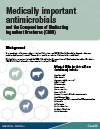Medically important antimicrobials and the CMIB
Background
In a continuing effort to combat antimicrobial resistance (AMR), Heath Canada is changing the way antimicrobials may be used. These changes affect antimicrobial use in livestock feed.
Medically important antimicrobials (MIAs) listed in the Compendium of Medicating Ingredient Brochures (CMIB) will also be listed on the prescription drug list (PDL).
Affected MIAs (or their salts or derivatives) include:
- avilamycinFootnote 1
- bacitracin
- emamectin benzoateFootnote 1
- florfenicolFootnote 1
- lincomycin
- neomycin
- ormetoprimFootnote 1
- penicillin G
- spectinomycin / dihydrostreptomycin
- sulphonamides
- tetracycline/ Chlortetracycline /Oxytetracycline
- tiamulin
- tilmicosin
- trimethoprimFootnote 1
- tylosin/ tylvalosin
- virginiamycin
The impacts of these changes are:
- MIAs will be identified with a "Pr" (prescription) designation in the CMIB.
- MIAs will no longer be labelled with growth promotion claims.
- Medicated feeds containing MIAs may continue to be manufactured according to the CMIB and may still be floor-stocked.
- Feeds medicated with MIAs will require a veterinary prescription before being sold to the end-user.
- Feeds containing MIAs that are prescribed in an extra-label manner (that is, not as per the CMIB) continue to require a veterinary prescription before being manufactured (no change to current requirements).
- Retailers cannot buy or sell this type of product unless entitled by the laws of the province/territory to do so, and the buyer must have a prescription from a veterinarianFootnote 2.
Key dates for implementation
April 1, 2018
- New CMIB will be posted on CFIA's website. Feed manufacturers may continue to use the old CMIB for labelling purposes until November 30, 2018 (the phase-in period).
December 1, 2018
- End of phase-in period: All floor-stock medicated feeds must be labelled as per the new CMIB in order to comply with the Feeds Regulations.
- Feed manufacturers may only sell feeds containing MIAs under the authority of a veterinarian (that is, with a veterinary prescription).
- Retailers cannot buy or sell this type of product unless entitled by the laws of the province/territory to do so, and the buyer must have a prescription from a veterinarianFootnote 2
Questions and Answers
Why are these changes being made?
Antimicrobial resistance (AMR) is a complex global problem that requires multifaceted solutions that are consistent around the world. These AMR initiatives are being implemented so that Canada's policies on the use of antimicrobials align with international best practices in an effort to reduce the effects of antimicrobial resistance on public health and help impact a global change.
Can I buy a drug premix (with a drug identification number [DIN]) listed on the prescription drug list?
End users will only be able to access/purchase Pr Drug Premix (bags with a DIN) from provincial/territorial-authorized facilities, including veterinary clinics and pharmacies, and a prescription will be needed from a veterinarian.
Is a Veterinary prescription required for sales of medically important antimicrobial DIN products (or feeds containing them) between commercial feed mills?
No. A veterinary prescription is not required for sales of these products between commercial feed mills or for sales to veterinarians and pharmacists.
Under these new AMR requirements, why are feed retail outlets not allowed to sell medicated feeds?
Feed retail outlets will still be able to sell feeds medicated with non-MIAs (for example, feeds medicated with ionophores). Provincial/territorial authorities determine who can sell feeds medicated with MIAs. Most provinces and territories in Canada do not permit feed retail outlets to sell prescription drug products (including feeds containing MIAs).
Previously the CMIB only provided information on over-the-counter (OTC) medications. Why does the CMIB now include prescription medications?
The CMIB, which is maintained by the CFIA, is an important resource for feed mills, veterinarians and producers. It provides instructions on how to manufacture medicated feeds and labelling directions for safe use. Including prescription medications in the CMIB will ensure that products are properly manufactured and labelled.
Will there be a phase-in period for the implementation of the new CMIB?
Yes. The phase-in period is from April 1 to November 30, 2018. During this time, the feed industry will have the choice to label feeds according to the previous version of the CMIB or the new version. Effective December 1, 2018, feeds must be labelled according to the new CMIB to be compliant under the Feeds Regulations.
If I have feed in-stock that was manufactured and labelled before December 1, 2018, what are my options to achieve compliance?
In situations like this, feed manufactures may re-label product in storage to meet the requirements of the new CMIB.
My facility manufactured and labelled feeds during the transition period, using the old version of the CMIB and still has these feeds in stock. Will they be exempt from the new CMIB requirements?
No. Feed manufacturers have from April 1 to November 30, 2018, to make the transition from the old CMIB to the new CMIB. As of December 1, 2018, all feeds must comply with the new CMIB in order to comply with the Feeds Regulations. CFIA inspection staff will follow normal inspection procedures when non-compliance is identified.
For more information
Contact your local CFIA office for more information or if you have questions.
- Date modified:
